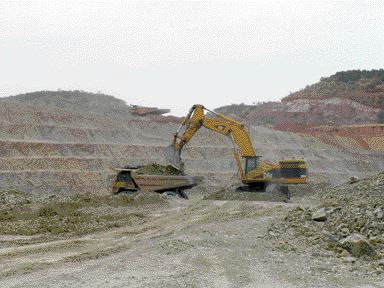The start of commercial production at the Samira Hill gold mine is cause for celebration for two Canadian mining companies, each of which holds a 40% stake in the open-pit operation. It’s also a milestone for the government of Niger, which has a 20% interest in the first mine ever to achieve commercial status in the African nation.
Samira Hill was developed on properties held by a Nigerien company owned 80% by African GeoMin Mining Development (AGMD) and 20% by the government of Niger.
The mine was built on time and on budget of US$27 million, and was officially opened last fall (T.N.M., Oct. 29-Nov. 4/04) with great fanfare. It is expected to generate significant economic and social benefits for Niger, one of the poorest nations in the world. In addition to its 20% interest, the government holds a 5.5% production royalty.
Samira Hill processed 436,398 tonnes grading 2.11 grams gold per tonne during its first full quarter of operations ended Dec. 31, 2004, and poured 22,006 oz. gold during that quarter. Full production for 2005 is forecast at 120,000 oz. while cash costs are estimated to average about US$203 per oz. over the mine life.
During the commissioning phase of the plant, significantly less cyanide, lime and peroxide were used than what was estimated by the feasibility study. If consumption of these materials continues at the same rate, operating costs will be lower than predicted.
The two main pits, Samira Hill and Libiri, are estimated to contain reserves totaling 10.1 million tonnes grading 2.21 grams of gold per tonne, from which 618,000 ounces will be recovered over the 6.3-year mine life.
The partners believe there is good potential to continue operations beyond the initial mine life as other satellite gold deposits are explored and developed along the 55-km-long “Samira Horizon,” which extends into neighbouring Burkina Faso.
Semafo also operates the Kiniero mine, in Guinea, which in 2004 produced 41,049 oz. gold from 411,948 tonnes of ore grading 3.36 grams gold per tonne. Kiniero produced more, 46,728 oz., in 2003. The shortfall reflects mechanical problems that forced the mill to shut down for more than a month.
A second ball mill has since been added, increasing total capacity by more than 25%. The mine is slated to pour 60,000 oz. in 2005.
In the first quarter of 2004, Kiniero had a proven and probable reserve of 1.9 million tonnes grading 3.82 grams gold per tonne, plus a measured and indicated resource of 5 million tonnes grading 3.12 grams gold. The estimates are based on cutoff grades of 1.3 grams gold per tonne for oxides and a 2.3 grams for sulphides.
This year, Semafo intends to spend a total $1.7 million in an effort to boost reserves at both Samira Hill and Kiniero.
Exploration is also under way on the Mana property, 200 km west of Ouagadougou, in Burkina Faso, where Semafo is revising a feasibility study. Recent drill results from the Wona deposit have added to reserves.
Total measured and indicated resources (including reserves) from the Nyafe and Wona deposits stand at 11.8 million tonnes grading 2.76 grams gold (equivalent to 1 million oz. gold). The amount of contained gold has increased by 26,300 oz. from the previous estimate. Estimates are based on a gold price of US$380 per oz. and a cutoff grade of 0.5 gram gold.
Deep drilling at Wona has increased the inferred resource by about 250%, to 7.5 million tonnes at a grade of 2.3 grams gold per tonne.
Wona has a proven and probable reserve of 6.3 million tonnes grading 2.45 grams gold, whereas Nyafe has a probable reserve of 561,800 tonnes grading 6.09 grams gold.
Total reserves for the two deposits combined are 6.92 million tonnes grading 2.78 grams gold per tonne, or 542,400 oz. gold.
The Nyafe zone is hosted by basalt and mafic-to-intermediate volcaniclastic rock.
Wona is in a series of deformed sedimentary and volcano-sedimentary, as well as meta-volcanic, rock. The rock is folded, sheared and brecciated. Northwest-trending faults cut the area, and shearing is generally northeasterly.
Gold is associated with silicification, sericitization, and quartz veining, primarily in mylonite or breccias. Pyrite and minor arsenopyrite are present. Gold may be free in quartz or in pyrite. It is also found in tellurides.
Mana is expected to produce at the monthly rate of 100,000 tonnes and last 6.5 years. Total cash costs are pegged at US$256 per oz.


Be the first to comment on "Samira Hill, Niger’s first gold mine, hits its strike"